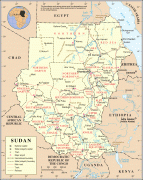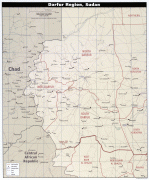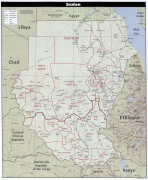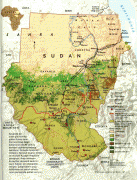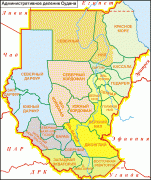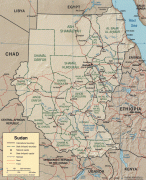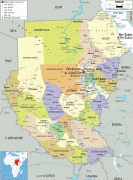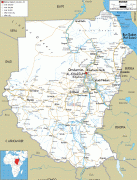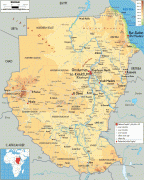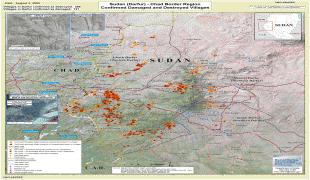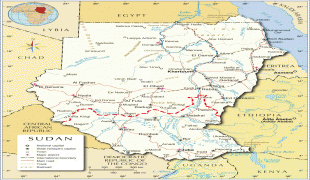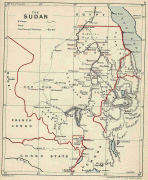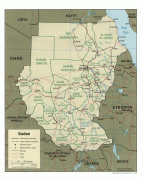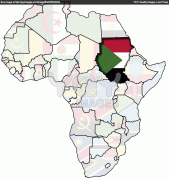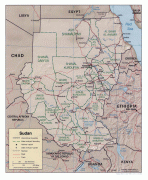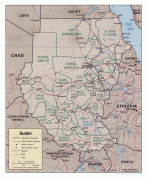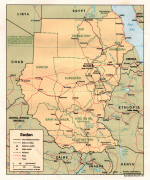Sudan (Republic of the Sudan)
 |
 |
| Flag of Sudan | |
Sudan's history goes back to the Pharaonic period, witnessing the Kingdom of Kerma (c. 2500–1500 BC), the subsequent rule of the Egyptian New Kingdom (c. 1500 BC–1070 BC) and the rise of the Kingdom of Kush (c. 785 BC–350 AD), which would in turn control Egypt itself for nearly a century. After the fall of Kush, the Nubians formed the three Christian kingdoms of Nobatia, Makuria, and Alodia, with the latter two lasting until around 1500. Between the 14th and 15th centuries, most of Sudan was gradually settled by Arab nomads. From the 16th to the 19th centuries, central and eastern Sudan were dominated by the Funj sultanate, while Darfur ruled the west and the Ottomans the east.
During the Mamluk and Ottoman periods, slave trade played a big role and was demanded from the Sudanese Kashif as the regular remittance of tribute. In 1811, Mamluks established a state at Dunqulah as a base for their slave trading. Under Turco-Egyptian rule of Sudan after the 1820s, the practice of trading slaves was entrenched along a north–south axis, with slave raids taking place in southern parts of the country and slaves being transported to Egypt and the Ottoman empire.
From the early 19th century, the entirety of Sudan was conquered by the Ottomans under the Muhammad Ali dynasty. It was under Turkish rule that Sudan acquired its modern borders and began the process of political, agricultural, and economic development. In 1881, nationalist sentiment in Egypt led to the Orabi Revolt, "weakening" the power of the Egyptian monarchy, and eventually leading to the occupation of Egypt by the United Kingdom. At the same time, religious-nationalist fervour in Sudan erupted in the Mahdist Uprising led by the self-proclaimed Mahdi Muhammad Ahmad, and resulting in the establishment of the Caliphate of Omdurman. The Mahdist forces were eventually defeated by a joint Egyptian-British military force, restoring the authority of the Egyptian monarch. However, Egyptian sovereignty in Sudan would henceforth be rather nominal, as the true power in both Egypt and Sudan was now the United Kingdom. In 1899, under British pressure, Egypt agreed to share sovereignty over Sudan with the United Kingdom as a condominium. In effect, Sudan was governed as a British possession. The 20th century saw the growth of both Egyptian and Sudanese nationalism focusing on ending the United Kingdom's occupation. The Egyptian revolution of 1952 toppled the monarchy and demanded the withdrawal of British forces from all of Egypt and Sudan. Muhammad Naguib, one of the two co-leaders of the revolution, and Egypt's first President, who was half-Sudanese and had been raised in Sudan, made securing Sudanese independence a priority of the revolutionary government. The following year, under Egyptian and Sudanese pressure, the United Kingdom agreed to Egypt's demand for both governments to terminate their shared sovereignty over Sudan and to grant Sudan independence. On 1 January 1956, Sudan was duly declared an independent state.
After Sudan became independent, the Jaafar Nimeiry regime began Islamist rule. This exacerbated the rift between the Islamic North, the seat of the government, and the Animists and Christians in the South. Differences in language, religion, and political power erupted in a civil war between government forces, influenced by the National Islamic Front (NIF), and the southern rebels, whose most influential faction was the Sudan People's Liberation Army (SPLA), which eventually led to the independence of South Sudan in 2011. Between 1989 and 2019, Sudan experienced a 30-year-long military dictatorship led by Omar al-Bashir, who was accused of human rights abuses, including torture, persecution of minorities, allegations of sponsoring global terrorism, and ethnic genocide due to its actions in the War in the Darfur region that broke out in 2003. Overall, the regime's actions killed an estimated 300,000 to 400,000 people. Protests erupted in 2018, demanding Bashir's resignation, which resulted in a coup d'état on 11 April 2019 and Bashir's imprisonment.
Islam was Sudan's state religion and Islamic laws were applied from 1983 until 2020 when the country became a secular state. Sudan is a developing country, and ranks 172nd on the Human Development Index as of 2022. Sudan has a lower-middle income economy which largely relies on agriculture due to long-term international sanctions and isolation, as well as a long history of internal instability and factional violence. Over 35% of Sudan's population lives in poverty. Sudan is a member of the United Nations, the Arab League, African Union, COMESA, Non-Aligned Movement and the Organisation of Islamic Cooperation.
The country's name Sudan is a name given historically to the large Sahel region of West Africa to the immediate west of modern-day Sudan. Historically, Sudan referred to both the geographical region, stretching from Senegal on the Atlantic Coast to Northeast Africa and the modern Sudan. The name derives from the Arabic (بلاد السودان), or "The Land of the Blacks". The name is one of various toponyms sharing similar etymologies, in reference to the more or less dark skin of the inhabitants. Prior to this, Sudan was known as Nubia and Ta Nehesi or Ta Seti by Ancient Egyptians named for the Nubian and Medjay archers or Bow men.
Currency / Language
| ISO | Currency | Symbol | Significant figures |
|---|---|---|---|
| SDG | Sudanese pound | جس. | 2 |
| ISO | Language |
|---|---|
| AR | Arabic language |
| EN | English language |






